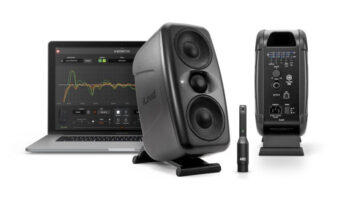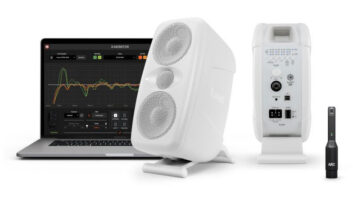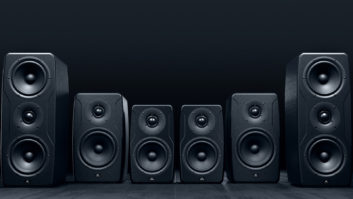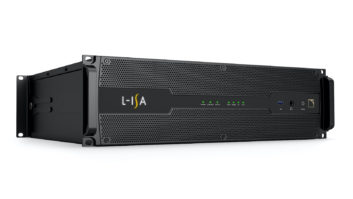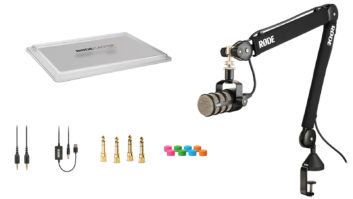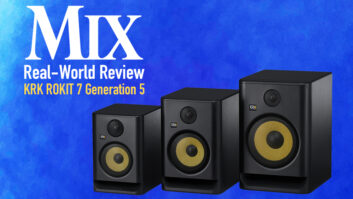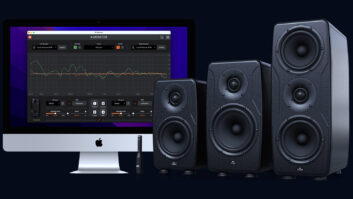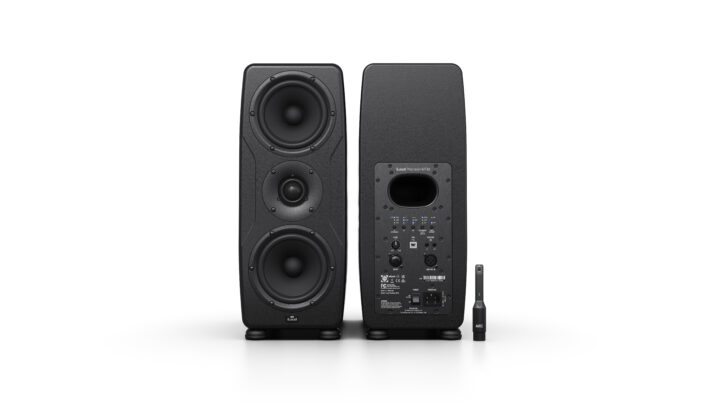
| MIX VERDICT: IK MULTIMEDIA ILOUD PRECISION MTM STUDIO MONITORS |
| THE TAKEAWAY: “If I were starting a studio anew or replacing older monitors, the iLoud Precision MTMs would be high on my wish list.” |
| COMPANY: IK Multimedia • www.ikmultimedia.com PRICE: $1,199 (per monitor), Remote Control: $69.99 PROS: • Impressive bass response. Comes with isolation pods for decoupling. • Excellent clarity in the midrange and highs. • ARC room-calibration system is fast and easy, and mic is included. • Multiple monitor emulations available. • Small footprint. • Comes with isolation pods for decoupling. CONS: • Relatively pricey. • Interaction of ARC and filtering options only partially explained in the documentation. |
IK Multimedia has a history of producing DSP-assisted studio monitors, and its Precision Series takes that technology to a new level. The series includes three models: the 5-inch Precision 5, the 6-inch Precision 6 and the Precision MTM (midwoofer-tweeter-midwoofer), featuring a pair of 5-inch woofers. All of the monitors are equipped with 1.5-inch tweeters.
Like the monitors in the company’s iLoud MTM series, the iLoud Precision Series incorporates the company’s ARC (Automatic Room Correction) technology, which calibrates them according to the acoustics at the listening position in your studio.
We’ll focus here on the Precision MTM monitors, which IK sent for review, but most of the features apply to all the models in the series.
The company clearly paid attention to detail in every aspect of this product, starting with the packaging. The monitors are packed very securely—each has an outer and inner box. When you open the former, you even get instructions for flipping it over to remove the monitors. Also included with each monitor: a power cable, USB cable, four isolation pods and a measurement microphone (with a clip).
The free X-Monitor software application, available from the IK site, enables additional functionality, including emulations of a variety of studio monitors, hi-fi speakers and device speakers. You also can use the monitors with a much smaller feature set without X-Monitor.
IK also offers an optional remote control that you use for the monitors’ calibration and voice-switching processes, though it’s a convenience, not a necessity.
SETUP
Each Precision MTM monitor has a relatively small footprint of 17.4 x 7 x 8.8 inches. They’re designed for vertical placement only, which makes it easier than you might expect to fit in a space-challenged studio. I fit them in the relatively small space available on my worktable. If they required horizontal placement—like many other MTMs—I would have used speaker stands and placed them further back.
On the back of each monitor are a bass reflex port, level control, USB input, Control In and Out jacks (for the optional remote), 1⁄4-inch/XLR combo input, female XLR input for the ARC calibration mic, IEC power input port, and an on/off switch.
After plugging in the power cables and the XLR main outputs from my audio interface, I connected each monitor to my computer with its included USB 2.0 (type A to B) cable, which is required for using the X-Monitor software. I also plugged in the optional Remote Control. Its cable, which terminates in a 3.5mm jack, gets plugged into the Control In port on the back of either monitor. Then you connect the Control Out jack to the Control In on the other speaker with another included 3.5mm cable.
Each monitor sports five control buttons on the rear panel. Three are for the built-in Contour switches designed to adjust for placement and separate from the ARC calibration. Contour switches include Low-Frequency Extension (highpass filter) and Low Frequency and High Frequency (low-shelf and high-shelf filters, respectively). Each of the filters offers five presets. If using X-Monitor, you get additional software-switchable presets.
The Cal/Preset button lets you select between Flat, Desk Filter (which compensates for desk reflections) and Cal, which switches the monitors to follow the ARC calibration settings. The final button turns Auto/Standby on and off. By default, the monitors go into standby after 60 minutes of inactivity. However, you can shorten or lengthen the standby time for each monitor in the X-Monitor software.
ARC OF THE MONITOR
The ARC calibration process is quick and relatively painless. After putting the calibration mic on a stand and connecting it to one of the monitors, you press and hold the CAL/Preset button for three or more seconds to put the speaker into Calibration mode.
The calibration process measures four mic positions per monitor. Positions 1 and 2 are to the front left and right of where you sit in your mix position. Positions 3 and 4 are also left and right, but just past the back of your head.
Once you initiate the calibration process, you get a five-second delay before the speaker emits test signals (“whoop whoop”). After the monitor emits four signals, you move the mic to the second position, press the button and repeat. After completing all four positions, you connect the mic to the other speaker and repeat the same steps. Getting the system calibrated was considerably faster and easier than other room-calibration systems I’ve tried.
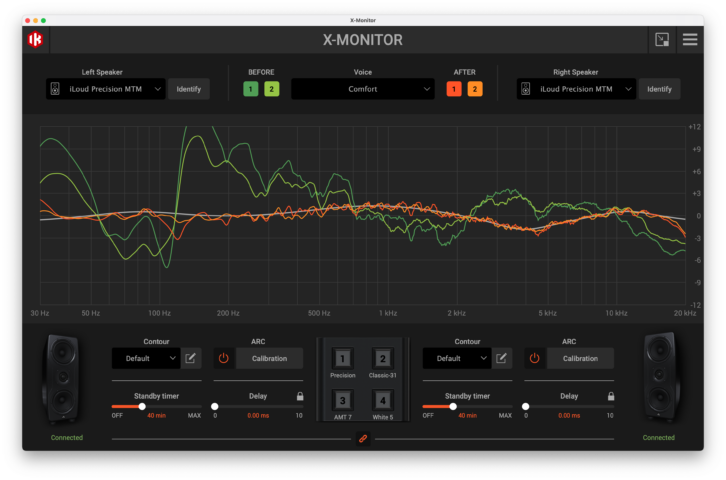
Once the process was complete, I could open X-Monitor and see a color-coded readout of the frequency curve from the calibration, both before and after the ARC processing. My studio had a considerable boost that peaked around 150 Hz and a dip between 1 and 2 kHz. The ARC-processed response flattened both of those out. I later redid the calibration to check its consistency, and the results were virtually identical.
If you have the optional Remote Control, a small device with four switches labeled 1 through 4, you can trigger the calibration of each position using the corresponding button on the remote. That saves you from walking behind the monitor to initiate the calibration process. When you’re finished with calibration, you can assign custom functions to the remote buttons, including Mute, Dim and specific monitor emulations.
The easiest way to do the ARC calibration is to trigger it from X-Monitor. The software guides you through the procedure with visual prompts.
THE X FACTOR
With the monitors connected to your computer via USB and with X-Monitor running, you can switch between 40 monitor-emulation Voices. Each Voice changes the frequency response to emulate a classic monitor or speaker. The processing for the Voices is independent of the ARC calibration. X-Monitor’s color-coded frequency display shows the effect on the frequency response when you change Voices. At the top of the list of optional Voices are three other versions of the iLoud Precision’s default sound: Wide Dispersion expands the vertical dispersion, which allows those who aren’t directly in the mix position to hear the monitors more accurately. Comfort offers a smoother response, with the upper midrange rolled off a little at around 4.5 kHz—designed to reduce ear fatigue in long sessions. High-Frequency Presence boosts frequencies above about 5 kHz and is designed to give you what the manual describes as “a smooth high-frequency presence boost that some engineers are searching for to avoid over-boosting the HF content on the program.”
IK Multimedia Updates Control for iLoud Precision Monitors
Next on the menu are all the monitor emulations. For legal reasons, presumably, IK doesn’t provide the exact product names but hints at them. Some examples include “Small Alu-29,” “Classic-31,” “Yellow 5,” etc. Also available are a small selection of multimedia speakers and Hi-Fi speaker emulations (the former includes a Bluetooth speaker, a TV and a Smartphone).
Within X-Monitor, you can choose from 15 different Contour settings, which, according to the manual, are extensions of the filters available on the rear panel. The Contour choices include Large Desk in a Corner, Small Desk Free, Large- Format Console and many others. You can adjust the Contour settings per band in a separate Contour display in X-Monitor. Because the Contour processing is separate from ARC, you can have both on simultaneously.
However, for whatever reason, if on any of the Contour settings that include one of the desk filters, it turns the ARC off automatically. I’m sure there’s a reason, but it’s not explained in the manual. Logically, if you have room acoustic issues, they will still be there whether you turn on or off the Desk filter.
REAL-LIFE RESULTS
I used the iLoud Precision MTMs as my primary monitors for about a month, working on several mixes and recording a few new songs during that time.
Although I preferred the default Precision Voice, with the ARC on, I found it helpful to compare my mixes on various monitor Voices. I was pleased with how my mixes turned out. They were well-balanced and translated successfully to external playback systems.
The monitors provided impressive frequency response, with powerful bass, full and warm midrange and clear highs. IK credits the precise time alignment (possible with the built-in DSP) as a significant reason for the clarity of the sound—and hearing is believing.
I thought these monitors sounded good even before calibrating them with ARC, but once I A/B’ed the uncalibrated and calibrated sound, I noticed that the latter offered significantly better clarity and significantly less lower-midrange resonance.
IK Multimedia has created a compelling product with these monitors. They’re compact, robust and versatile. Although relatively pricey, their ability to emulate so many different monitor types means they could efficiently serve as the only monitor pair in your studio. If I were starting a studio anew or replacing older monitors, the iLoud Precision MTMs would be high on my wish list.
Finally, I noticed that music retailers were not just selling pairs of the Precision MTMs but also offering 9-speaker bundles. IK is also aiming this product at the immersive market, where it could be extremely useful.
